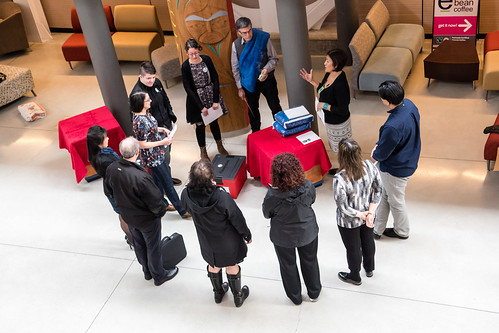
The honoring ceremony begins. Joanne Stone-Campbell explains the BCIT Aboriginal Services blankets that cover the bentwood boxes. Photographer, Scott McAlpine
On February 29, 2016, Leap Day, a few people from the BCIT community gathered for a ceremony to honour the artist James Michels and to seal the two bentwood boxes that he made for this purpose. The boxes will not be opened until BCIT’s 75th Anniversary in 2039-2040.
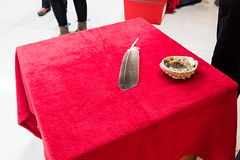
Feather and Smudge shell on top of one of the Blanketed cedar bentwood boxes. Photographer, Scott McAlpine
The honouring ceremony began with a cleansing Smudge lead by Alf Dumont, BCIT Aboriginal Services Elder and BCIT Aboriginal Services Advisor. He offered the smoke from tobacco, cedar, sage, and sweet grass to all who were there, as a way of preparing ourselves for the experience we are going into. “This allows us to focus on what is about to happen,” Elder Alf said. “We are putting memories of our community into these boxes, we are all responsible to carry memories.” Everyone present was invited to sweep the smoke over themselves and draw it into their hearts.
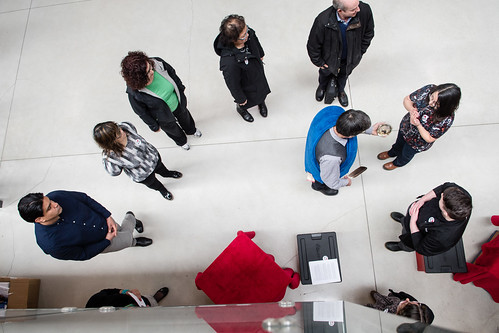
Mirabelle Rohatgi taking the Smudge offered by Alf Dumont. Photographer, Scott McAlpine
Joanne Stone-Campbell, BCIT Aboriginal Services coordinator, spoke about the significance of the boxes. They were made by artist James Michels of the Cree and Metis nations, in the traditional Northwest Coast method of steaming and bending a single plank of cedar wood into the shape of the box. Stone-Campbell explained that the blanketing ceremony honours “the importance of our gifts to be put in the time capsule.”
The boxes housed within the bentwood boxes are fireproof and waterproof. They hold memories and stories of the BCIT community as we celebrated our 50th Anniversary. More than fifty items have been included in the 2014/2015 time capsule. These include local and national news articles about BCIT during its’ 50th year, 50th anniversary promotional items and memorabilia, as well as letters to the future. Some highlights include a replica vintage ‘I *heart* BCIT’ button, three banners representing the different BCIT 50 years colours, the special edition BCIT & Beyond Link Magazine 2015, The Vancouver Sun, Saturday, October 4, 2014,’BCIT: 50 years and counting: Institute broke new ground and launched thousands of careers,’ and the gorgeous, limited edition, BCIT 50 Years viewbook (only 60 copies printed). BCIT Aboriginal Services graciously contributed many special items and photographs including a wood box representing a bentwood box, decorated with the Aboriginal Services logo, designed by Chief Ian Campbell, Squamish Nation. The design represents mind, body, spirit and the Coast Salish welcome, hands held up. This item was given to grads and special guests for the June 2014 Aboriginal Graduation Ceremony.
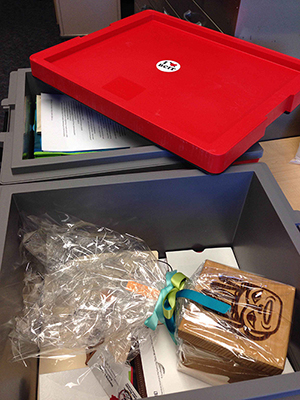
Time Capsule boxes as they were being packed. Photographer, C. McLellan
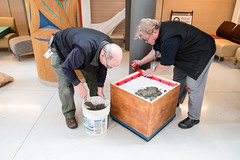
Bill Their and Rene Jacques sealing the boxes. The storage boxes were packed with foam, then a layer of plywood, more Styrofoam, tape and then a fast-drying sealant. Once dry they will be topped with the artist-made solid cedar lids that are painted to match the House Post. Photographer, Scott McAlpine
BCIT Aboriginal Services thanked everyone involved in the process of the safe housing of the Time capsule; from the artist to the people from facilities who did the planning for the sealing and the labour.
Once Their had smoothed the concrete Dumont was given the honour of marking the wet sealant.
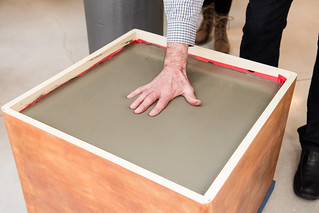
Elder Alf Dumont getting his hand dirty for posterity! Photographer, Scott McAlpine
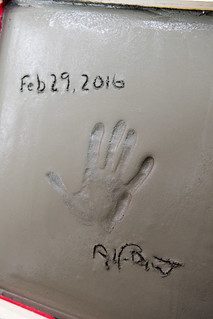
The date, Dumont’s handprint and signature. Photographer, Scott McAlpine
For the sealing of the second box everyone got in on the fun. Writing in wet cement is harder than you might guess. Donna Woo made it look easy!
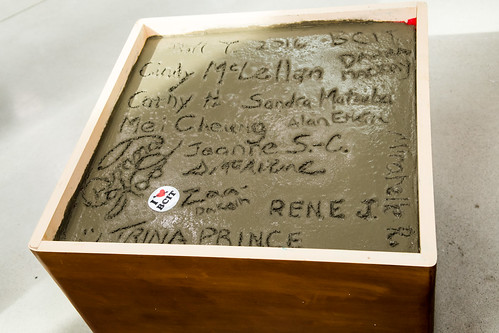
The ‘I LOVE BCIT’ sticker fell off Sandra Matsuba’s jacket and there it stays for the next 25 years! Photographer, Scott McAlpine
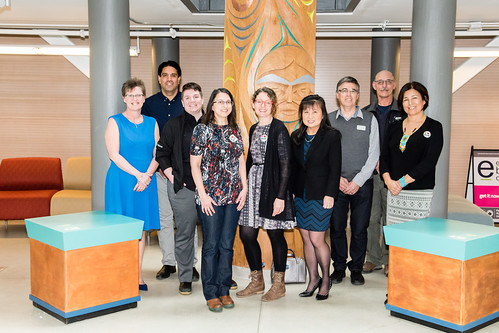
Thanks to everyone who made it a special event! And a heartfelt shout out to those who had other places to be. Photographer, Scott McAlpine
Where will you be in 2039-2040? What significant changes do you see happening to BCIT in the next 25 years? If the people planning the unveiling plan it just right they can do it on a Leap Day. See you on February 29th 2040!
I was honoured to be a part of this project and delighted with my silk scarf decorated with the Aboriginal Services logo. As an archivist I spend a fair amount of my time looking back at history. I believe that looking back is a powerful way to plan and be ready for the future. Putting together this Time Capsule invited us to meditate on where we might be in 25 years. I will end with the quote about Archives and the power of Archives that I used at the end of the ceremony. A dear friend and fellow archivist in the UK, Geoffery Yeo:
Archives and records are important resources for individuals, organizations and the wider community. They provide evidence of, and information about, the actions of individuals, organizations and communities and the environments in which they occurred. They extend and corroborate human and corporate memory and play a critical role in maintaining awareness of how the present is shaped by the past…they are among the tools we can use to help us understand where we came from and where we are going.